Author:没羽@阿里移动安全
0x00 前言
对于protobuf over-HTTP的数据交互方式Burpsuite不能正确的解析其中的数据结构,需要Burpsuite扩展才能解析,笔者使用mwielgoszewski的burp-protobuf-decoder【1】扩展实践了protobuf数据流的解析,供有需要的同学学习交流。笔者实践使用的环境: burpsuite+python2.7+protobuf2.5.0。
0x01 安装burp-protobuf-decoder扩展
burp-protobuf-decoder【1】扩展是基于protobuf库(2.5.x版本)开发的burpsuite python扩展,可用于解析、篡改 request/response中protobuf数据流。从https://github.com/mwielgoszewski/burp-protobuf-decoder下载该扩展源码,然后解压。
该扩展是基于protobuf和jython实现的。先下载protobuf 2.5.0【2】源码进行编译,编译方法请参考其README.txt文件。需求在burpsuite的Extender中配置Jython【3】的路径:

Burpsuite中添加扩展:
-
在Burpsuite的Extender窗口中点击“Add”按钮,弹出的“Load Burp Extension”窗口中选择如下信息:
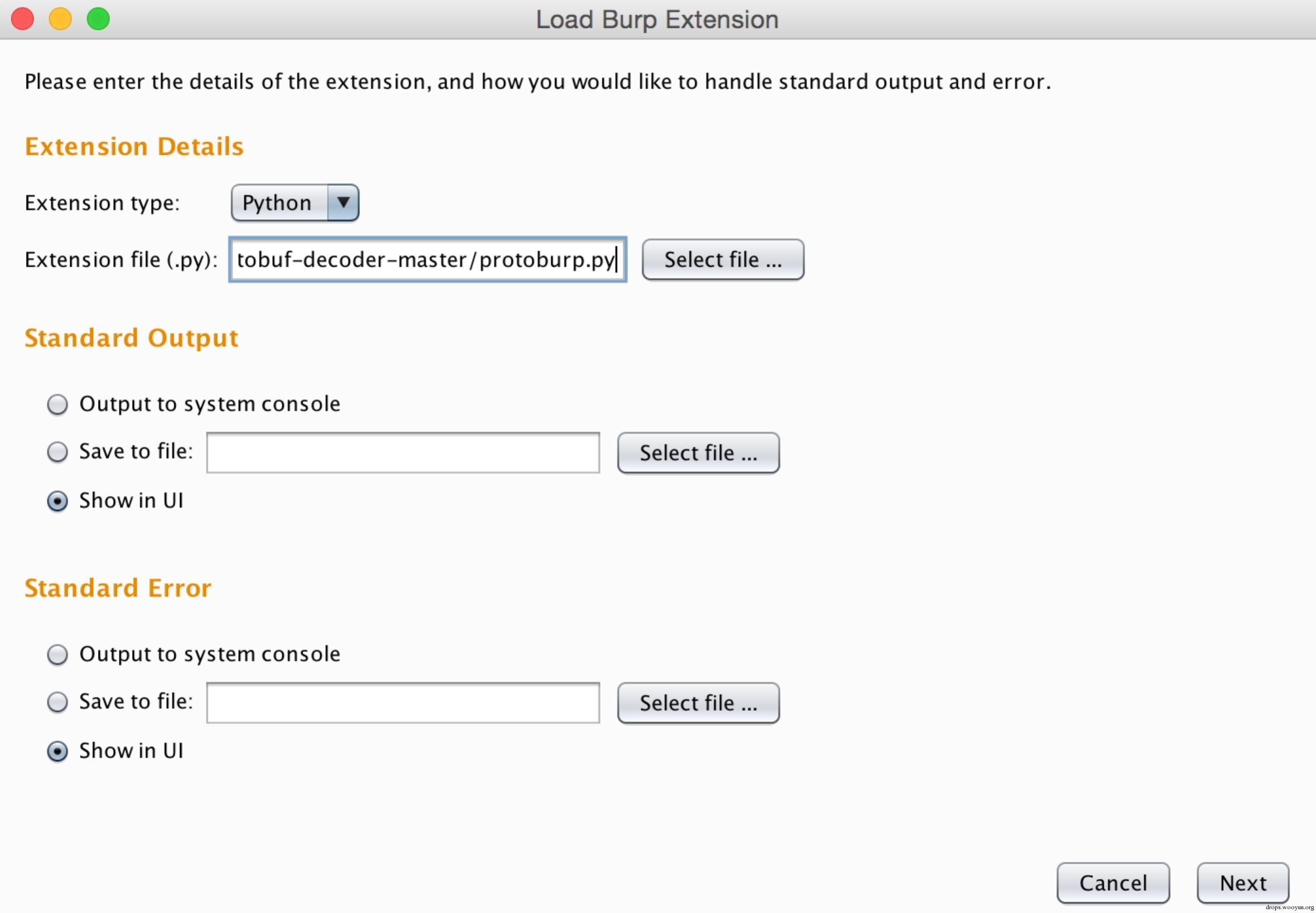
-
然后Next,当看到如下信息时表示扩展加载成功:

Tips:
-
加载扩展时提示
“Error calling protoc: Cannot run program "protoc" (in directory "******"): error=2, No such file or directory”错误解决办法:修改protoburp.py中调用protoc命令的路径,有多处,如:
将
process = subprocess.Popen(['protoc', '--version']中'protoc'改为'/home/name/protobuf/src/protoc'。 -
加载扩展碰到
cannot import name symbol_database错误可能是你使用的protoc与扩展所使用protobuf python库版本不一致原因,一种解决办法是下载protobuf 2.5.0源码编译后,修改protoburp.py中对应的路径,再加载扩展。
-
扩展加载成功了,但不能解析protobuf数据流
该扩展通过判断头部“content-type”是否为“
'application/x-protobuf'”来决定是否解析数据,你可以修改protoburp.py中的isEnabled()方法让其工作。
0x02 protobuf简介
protobuf是Google开源的一个跨平台的结构化数据存储格式。可用于通讯协议、数据存储等领域的语言无关、平台无关、可扩展的序列化结构数据格式。
protobuf通过定义“.proto”文件来描述数据的结构。.proto文件中用 “Message”来表示所需要序列化的数据的格式。Message由Field组成,Field类似Java或C++中成员变量,通常一个Field的定义包含修饰符、类型、名称和ID。下面看一个简单的.proto文件的例子:
syntax = "proto2";
package tutorial;
message Person {
required string name = 1;
required int32 id = 2;
optional string email = 3;
enum PhoneType {
MOBILE = 0;
HOME = 1;
WORK = 2;
}
message PhoneNumber {
required string number = 1;
optional PhoneType type = 2 [default = HOME];
}
repeated PhoneNumber phone = 4;
}
message AddressBook {
repeated Person person = 1;
}
使用下面的python代码生成二进制数据流:
import addressbook_pb2
address_book = addressbook_pb2.AddressBook()
person = address_book.person.add()
person.id = 9
person.name = 'Vincent'
person.email = 'Vincent@test.com'
phone = person.phone.add()
phone.number = '15011111111'
phone.type = 2
f = open('testAb', "wb")
f.write(address_book.SerializeToString())
f.close()
序列化后的二进制数据流如下:

有关Protobuf的语法网上已有很多文章了,你可以网上搜索或参考其官网【4】说明。
2.1Varint编码
Protobuf的二进制使用Varint编码。Varint 是一种紧凑的表示数字的方法。它用一个或多个字节来表示一个数字,值越小的数字使用越少的字节数。这能减少用来表示数字的字节数。
Varint 中的每个 byte 的最高位 bit 有特殊的含义,如果该位为 1,表示后续的 byte 也是该数字的一部分,如果该位为 0,则结束。其他的 7 个 bit 都用来表示数字。因此小于 128 的数字都可以用一个 byte 表示。大于 128 的数字,比如 300,会用两个字节来表示:1010 1100 0000 0010。
下图演示了protobuf如何解析两个 bytes。注意到最终计算前将两个 byte 的位置相互交换过一次,这是因为protobuf 字节序采用 little-endian 的方式。
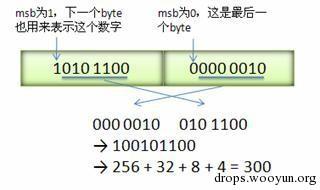 _
_
2.2数值类型
Protobuf经序列化后以二进制数据流形式存储,这个数据流是一系列key-Value对。Key用来标识具体的Field,在解包的时候,Protobuf根据 Key 就可以知道相应的 Value 应该对应于消息中的哪一个 Field。
Key 的定义如下:
(field_number << 3) | wire_type
Key由两部分组成。第一部分是 field_number,比如消息 tutorial .Person中 field name 的 field_number 为 1。第二部分为 wire_type。表示 Value 的传输类型。Wire Type 可能的类型如下表所示:
| Type | Meaning | Used For |
|---|---|---|
| 0 | Varint | int32, int64, uint32, uint64, sint32, sint64, bool, enum |
| 1 | 64-bit | fixed64, sfixed64, double |
| 2 | Length-delimi | string, bytes, embedded messages, packed repeated fields |
| 3 | Start group | Groups (deprecated) |
| 4 | End group | Groups (deprecated) |
| 5 | 32-bit | fixed32, sfixed32, float |
以数据流:08 96 01为例分析计算key-value的值:
08 = 0000 1000b
=> 000 1000b(去掉最高位)
=> field_num = 0001b(中间4位), type = 000(后3位)
=> field_num = 1, type = 0(即Varint)
96 01 = 1001 0110 0000 0001b
=> 001 0110 0000 0001b(去掉最高位)
=> 1 001 0110b(因为是little-endian)
=> 128+16+4+2=150
最后得到的结构化数据为:
1:150
其中1表示为field_num,150为value。
2.3手动反序列化

以上面例子中序列化后的二进制数据流进行反序列化分析:
0A = 0000 1010b => field_num=1, type=2;
2E = 0010 1110b => value=46;
0A = 0000 1010b => field_num=1, type=2;
07 = 0000 0111b => value=7;
读取7个字符“Vincent”;
10 = 0001 0000 => field_num=2, type=0;
09 = 0000 1001 => value=9;
1A = 0001 1010 => field_num=3, type=2;
10 = 0001 0000 => value=16;
读取10个字符“Vincent@test.com”;
22 = 0010 0010 => field_num=4, type=2;
0F = 0000 1111 => value=15;
0A = 0000 1010 => field_num=1, type=2;
0B = 0000 1011 => value=11;
读取11个字符“15011111111”;
10 = 0001 0000 => field_num=2, type=0;
02 = 0000 0010 => value=2;
最后得到的结构化数据为:
1 {
1: "Vincent"
2: 9
3: "Vincent@test.com"
4 {
1: "15011111111"
2: 2
}
}
2.4使用protoc反序列化
实现操作经常碰到较复杂、较长的流数据,手动分析确实麻烦,好在protoc加“decode_raw”参数可以解流数据,我实现了一个python脚本供使用:
def decode(data):
process = subprocess.Popen(['/usr/local/bin/protoc', '--decode_raw'],
stdin=subprocess.PIPE,stdout=subprocess.PIPE,stderr=subprocess.PIPE)
output = error = None
try:
output, error = process.communicate(data)
except OSError:
pass
finally:
if process.poll() != 0:
process.wait()
return output
f = open(sys.argv[1], "rb")
data = f.read()
print 'data:\n',decode(data)
f.close()
使用python decode.py <proto.bin>即可反序列化,其中proto.bin为protobuf二进制数据流文件。得到结构化的数据后我们可以逐步分析,猜测每个Field的名称,辅助协议、数据结构等逆向分析。
0x03 burpsuite+protobuf实战
用webpy模拟protobuf over-HTTP的web app。
服务端overHttp_server.py内容如下:
1 2 3 4 5 6 7 8 9 10 11 12 13 14 15 16 17 18 19 20 21 22 23 24 | |
客户端overHttp_client.py内容如下:
1 2 3 4 5 6 7 8 9 10 11 12 13 14 15 16 17 18 19 20 21 22 23 24 25 26 27 28 29 30 31 32 33 34 35 | |
3.1proto文件逆向分析
启动服务端:python overHttp_server.py <ip>:8080
客户端请求:python overHttp_client.py
此时burp中已解析出protobuf数据,如下图:

但是这个结构的可读性还是比较差,我们可以通过逆向分析逐步猜测字段名称、类型,然后再解析,方便实现协议的逆向、安全测试等。
对这个结构我们可以还原成以下proto文件:
syntax = "proto2";
package reversed.proto1;
message Msg {
optional string _name = 1;
optional int32 field2 = 2;
optional string _email = 3;
message subMsg1 {
required string _phone = 1;
optional int32 sub1_field2 = 2;
}
repeated subMsg1 field4 = 4;
}
message Root {
repeated Msg msg = 1;
}
然后使用右键的“Load .proto”加载该文件:
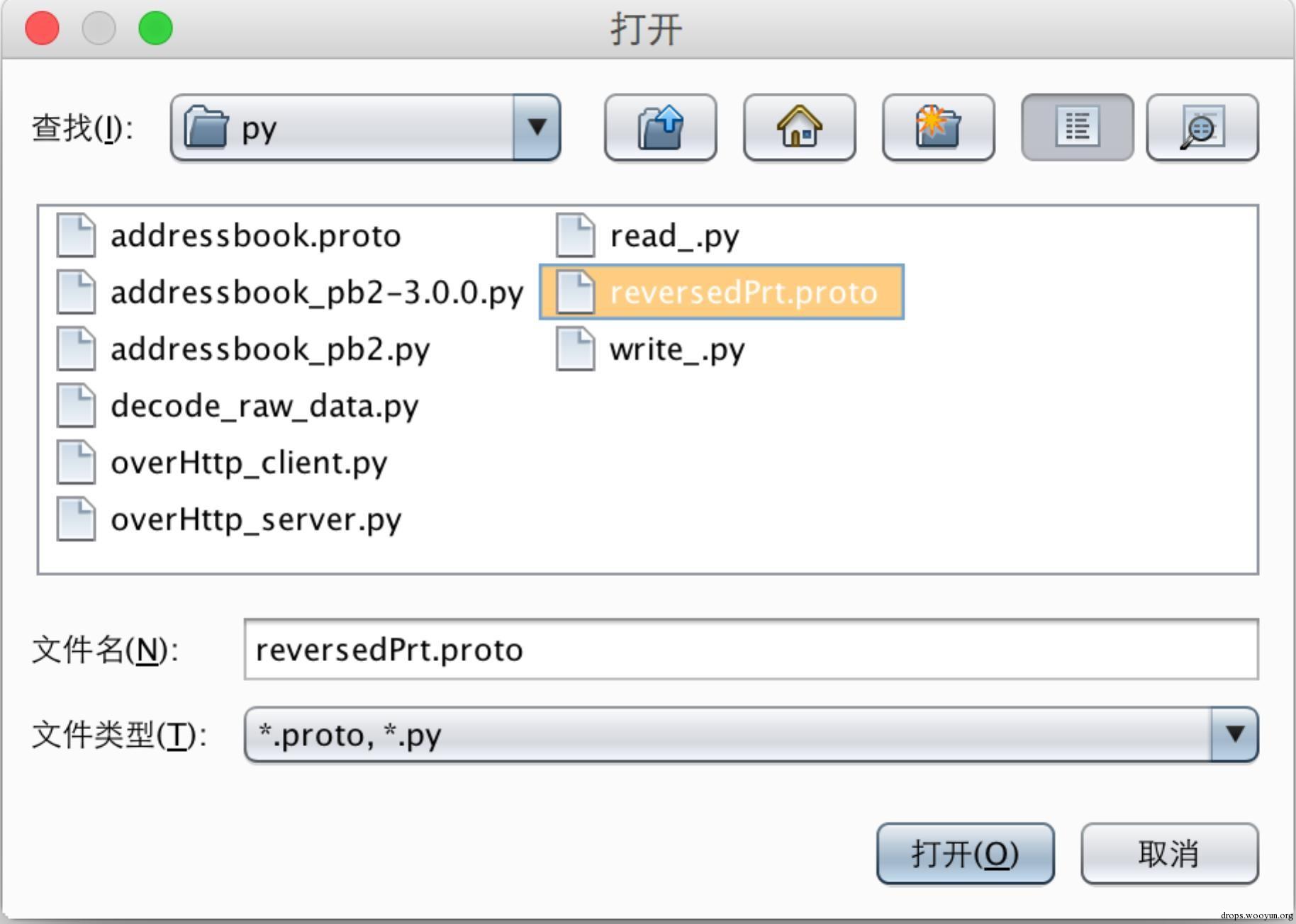
再看解析结果:
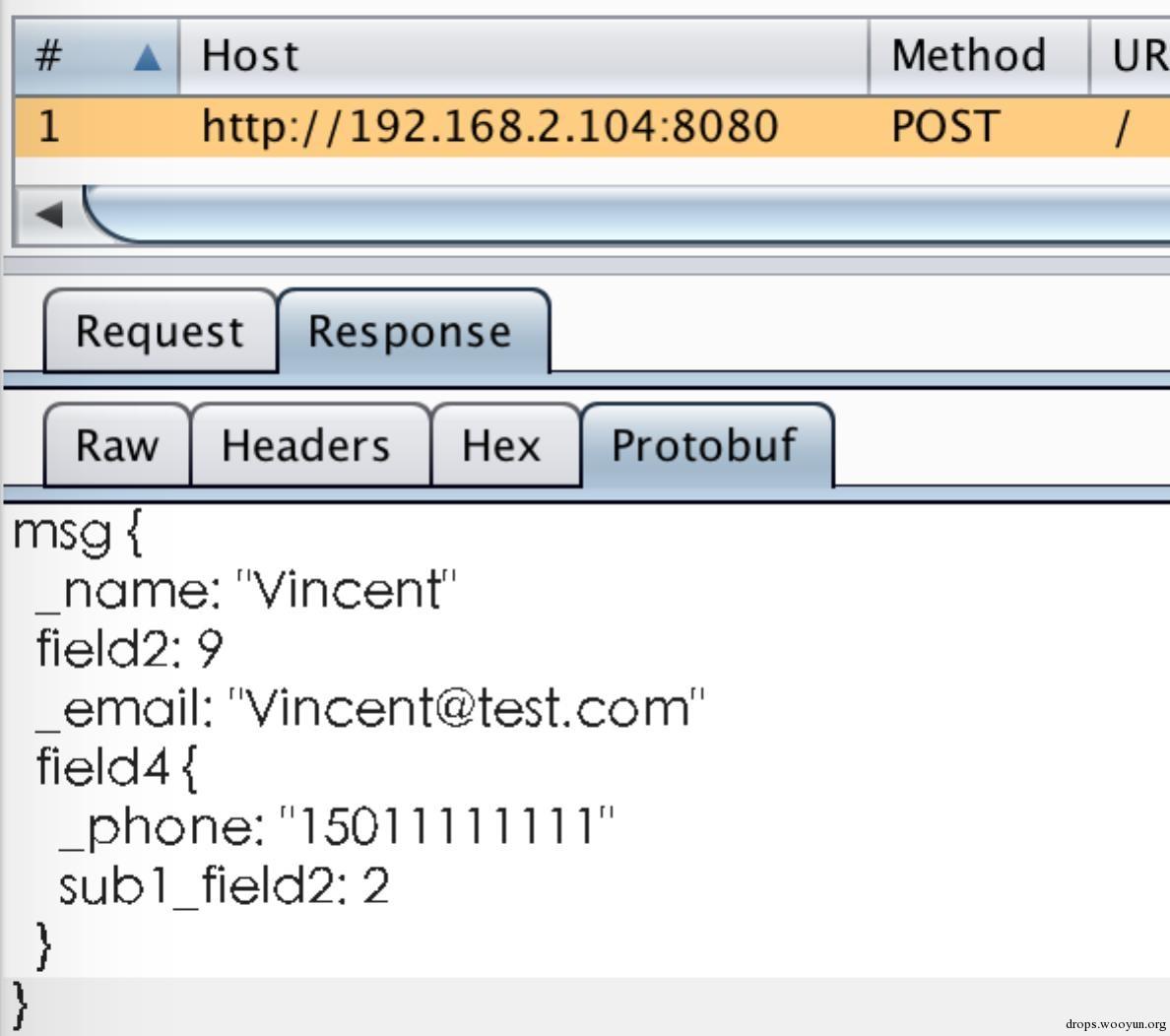
3.2数据篡改
打开request拦截:

运行python overHttp_client.py发送请求。拦截到request后,把sub1_field2改为999。

“Forward”后看request数据,已被篡改:
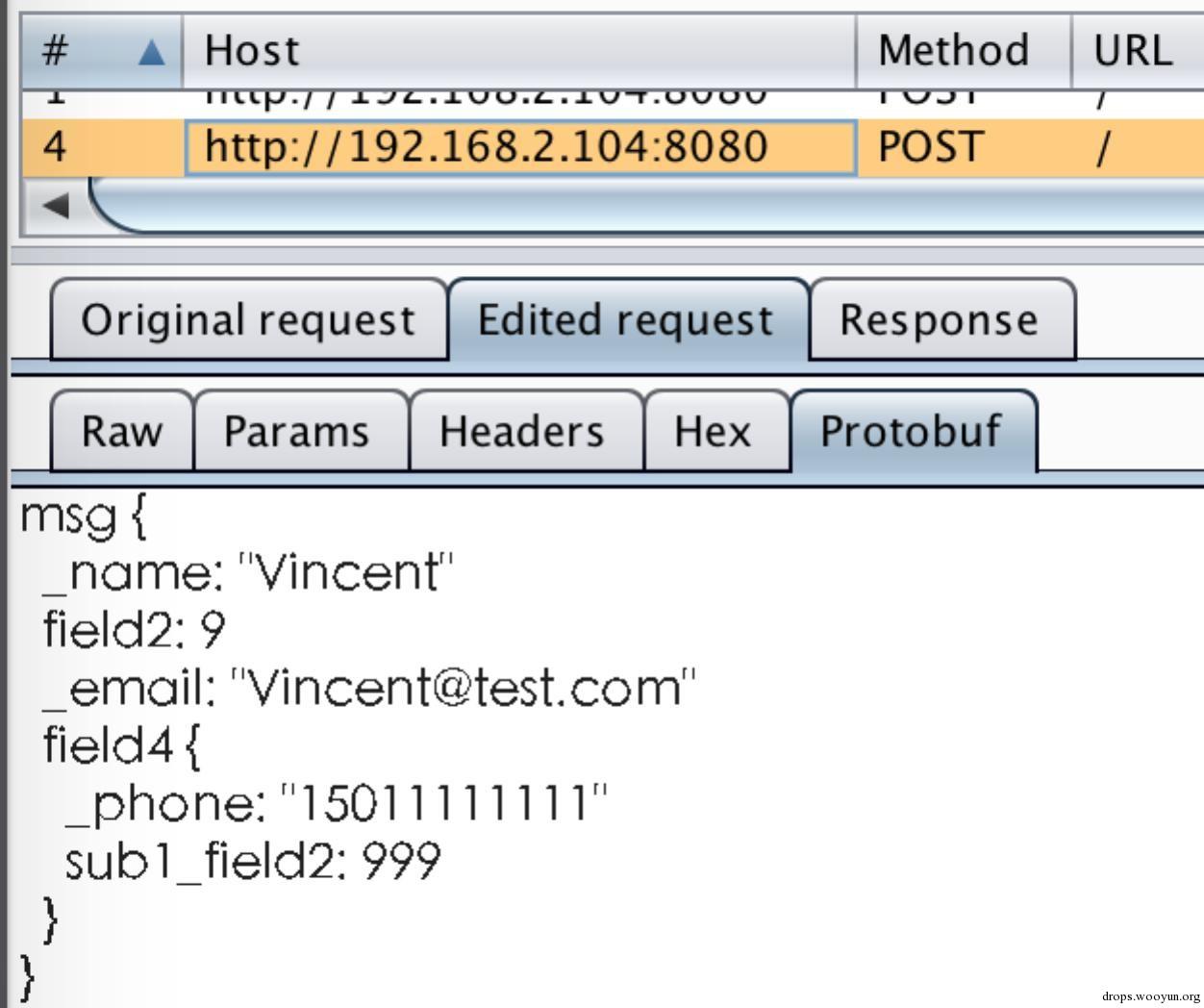
0x04 参考
- 【1】https://github.com/mwielgoszewski/burp-protobuf-decoder
- 【2】https://github.com/google/protobuf/tree/v2.5.0
- 【3】https://wiki.python.org/jython/InstallationInstructions
- 【4】https://developers.google.com/protocol-buffers/docs/proto
- 【5】https://www.ibm.com/developerworks/cn/linux/l-cn-gpb/
- 【6】https://developers.google.com/protocol-buffers/docs/overview
- 【7】http://www.tssci-security.com/archives/2013/05/30/decoding-and-tampering-protobuf-serialized-messages-in-burp/
 跳跳糖
跳跳糖
